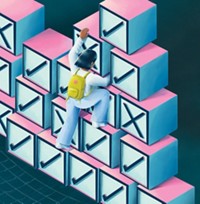Advertisement
Grab your lab coat. Let's get started
Welcome!
Welcome!
Create an account below to get 6 C&EN articles per month, receive newsletters and more - all free.
It seems this is your first time logging in online. Please enter the following information to continue.
As an ACS member you automatically get access to this site. All we need is few more details to create your reading experience.
Not you? Sign in with a different account.
Not you? Sign in with a different account.
ERROR 1
ERROR 1
ERROR 2
ERROR 2
ERROR 2
ERROR 2
ERROR 2
Password and Confirm password must match.
If you have an ACS member number, please enter it here so we can link this account to your membership. (optional)
ERROR 2
ACS values your privacy. By submitting your information, you are gaining access to C&EN and subscribing to our weekly newsletter. We use the information you provide to make your reading experience better, and we will never sell your data to third party members.
Undergraduate Education
The flip side of flipped classrooms
Popular teaching method doesn’t always work as planned
by Claire L. Jarvis, special to C&EN
January 17, 2020
| A version of this story appeared in
Volume 98, Issue 3

Clarissa Sorensen-Unruh thought she had the day’s lesson clinched. Her general chemistry class at Central New Mexico Community College was going to play a card game as a way of illustrating reaction rate principles. She’d taught this course many times before, using a “flipped” classroom format, and this exercise was always well received.
Except that day in fall 2014 it wasn’t. The students didn’t grasp the rules; they didn’t understand how the card game was connected to reaction rates; they weren’t in the mood to play games. Concentration slipped. Several students left early. “I was like, ‘Wow, that worked three times, but now it doesn’t work at all; how very interesting.’ Just because it works for one group doesn’t mean it’s going to work for another,” Sorensen-Unruh recalls.
For educators who teach using the flipped classroom model—in which students watch lectures online before class and then engage in practical activities during class time to help cement concepts—Sorensen-Unruh’s experience is familiar. Flipped classrooms are challenging to get right, and they demand a different skill set from instructors accustomed to lecturing.
But the chemical education literature doesn’t always include these caveats, and Sorensen-Unruh notes that negative academic results from flipped classrooms are rarely published. Numerous papers report that students obtain higher grades in flipped classrooms than in traditional lectures. And they report that struggling students or those from underrepresented groups boost their performance.
In reality, flipped classrooms’ effectiveness is often limited. Many flipped classrooms fail to raise students’ scores, and when poorly implemented can even disadvantage vulnerable students. A report in 2019 of a randomized controlled trial conducted in 2016 at the US Military Academy at West Point found flipped classrooms improved short-term quiz scores in math but conferred no long-term academic benefits in math or economics and in fact widened the achievement gap between white male students and their peers.
Part of the problem, for chemistry classrooms and beyond, is that many faculty running the studies already know how to properly flip classrooms, Sorensen-Unruh says. Or they know about small things that contribute to a flipped classroom’s success but that a less-experienced educator wouldn’t think to do, she adds.
And journals, chemical education versions included, usually publish only positive results, so the literature often ignores flipped-classroom failures.
Amanda Holton encountered the gap between the optimistic literature and reality when she first flipped her large general chemistry class. Most published studies in chemistry-focused journals focus on flipped classrooms for chemistry majors and smaller upper-level classes. In contrast, Holton’s students at the University of California, Irvine, where she’s a teaching-track professor in the Chemistry Department, were in their first semester of college, nonmajors taking general chemistry as a prerequisite for their biology degrees. They weren’t strongly motivated to study chemistry and resented having to run through lectures and teach themselves outside the classroom. Exam performance only slightly improved compared with students who took the nonflipped version the year before.
Sorensen-Unruh says that students in introductory courses are still figuring out college life and therefore find adjusting to flipped classrooms challenging. Students midway through their studies are the most amenable to active learning, the umbrella term for any pedagogical approach requiring students to take part in activities that teach them new concepts and apply their existing knowledge instead of passively listening to lectures. “Those students are much more willing to play in the sandbox,” Sorensen-Unruh says.
“There’s an attitude that ‘if the instructor isn’t talking, they aren’t teaching,’ and trying to get 18-year-olds over that is very difficult,” Holton admits. Some students view flipped classrooms as an excuse by the teacher to get out of doing work, according to Renee Link, also a teaching-track professor in the Chemistry Department at UCI. “They have this misconception that this was somehow easier for me, and I had to quickly disabuse them of that notion. No, no, this is way more work! I wouldn’t be doing it if I didn’t think it was better for you,” Link says.

Source: Adapted from J. Chem. Educ. 2019, DOI: 10.1021/acs.jchemed.9b00767.
In subsequent years, Holton dialed back the flipped aspects of her general chemistry course and reincorporated lectures, albeit shorter ones with breaks for in-class practice problems. Students were reassured by the presence of lectures. “I joke it’s like hiding vegetables in food for your kids,” Holton says. Practicing problems helped nonmajors who lacked confidence in their ability to succeed at general chemistry. “Having the softer version of the flipped classroom allowed for a lot more cheerleading in class with them.”
Most educators admit that a successful flipped classroom requires thoughtful public relations work. “I’m concerned about branding because if this course is categorized as a flipped classroom and students have had a negative experience with that, then it’s not going to be smooth sailing for us,” says Viji Sathy, a teaching-track professor at the University of North Carolina at Chapel Hill who brands her flipped statistics course as “highly structured active learning.”
Many instructors spend class time selling the benefits of flipped classrooms and active learning to students. “Instructors have read all the literature on flipped classrooms and seen all the research that this is favorable. Our students don’t read those papers,” says Matthew Stoltzfus, a senior lecturer of chemistry at the Ohio State University who teaches a flipped general chemistry course.
When running a flipped classroom, educators often have to teach their students how to learn. Time needs to be devoted during class to explaining effective study habits and intended learning outcomes of games and tests. On “Metacognitive Mondays,” Holton devotes 5–10 min of class time to principles of learning.
Sathy notes many college students relied on learning techniques such as cramming and memorization during high school that didn’t help them understand the material. These techniques hamper students in college, often without their realizing it. For that reason, instructors shouldn’t just flip the class and expect students to know how to learn the material. “Focus more on what students are doing outside of class rather than what you’re doing in class. I only see my students 3 h a week. There’s many more hours that students are going to be working outside the class,” Stoltzfus says.
Faculty must also be mindful of how the flipped classroom can disadvantage nontraditional students if not implemented correctly, experts say. “The expectation of the flipped classroom is that it requires a fair amount of work outside the classroom, and part-time students or those with significant nonacademic responsibilities may not have as much time to dedicate to their studies as more traditional students who live on campus,” says Jack Barbera, a professor of chemistry at Portland State University.

Holton asked her students to self-report their study hours when taking the flipped and traditional lecture versions of her course: she found that students in the flipped version put in one extra hour on average per week of study time before class but reported needing less study time after. They didn’t need to cram as much before finals. A carefully flipped classroom shouldn’t drastically increase the time students devote to the course, Holton argues.
Another issue that educators should consider when flipping a classroom is that “active learning changes the dynamics of the classroom,” says Sara Brownell, a professor of life sciences at Arizona State University who studies how social identity affects students in biology classrooms. “In traditional lectures where the students just sit there and passively absorb information while the instructor is talking, who the students are matters a lot less. In an active learning classroom, on the other hand, students interact much more, and “they end up thinking about whether they should reveal their identity far more.”
Group activities are a central component of many flipped classrooms, helping cement key concepts and raise grades. Brownell recommends students should be allowed to self-select groups in these environments. Keeping everybody in the same groupings throughout the semester can help LGBTQ+ students or students with anxiety disorders feel more comfortable, reducing the stress of repeatedly outing themselves to new people every time they change groups. Group self-selection also reduces the risk of students being marginalized by their peers during class.
Basic space logistics can also impede the effectiveness of flipped classrooms. When Link first flipped her large organic chem class, she was in a typical university auditorium designed for lecturing. “It was difficult for me to get to students in the middle of the rows; it was difficult for students to work together because that’s not what a lecture hall is structured for,” she says. Once her class moved into a specially designed active learning classroom with circular tables, students automatically struck up conversations with their neighbors and found it easier to work together.
Because every cohort enters with a different knowledge base, adaptability is crucial in successful flipped classrooms, experts say. In addition to homework exercises and in-class quizzes, Holton conducts weekly surveys on student attitudes toward the latest lessons and confidence with the material. Real-time course feedback allows her to make adjustments quickly and retain student buy-in.
Although more and more papers have been published about the results of flipping classrooms over the past few years, it’s difficult to come up with a conclusion about which model works best and why. That’s because each classroom is different. Some instructors make students watch videos before class; others provide reading guides. And various instructors structure in-class time differently. “It’s slightly problematic trying to compare study results when everybody has their own way of showing ‘Here’s what my students thought; here’s what the impacts were,’ ” Portland State University’s Barbera says.
Barbera is taking a multi-institutional look at flipped-classroom effectiveness. His team monitored eight flipped chemistry classrooms at five institutions, all structured in a slightly different way. Focus groups, pre- and postcourse student surveys, and classroom recordings meant his team could compare different classroom outcomes in a standardized way.
Video recordings give the team lots of information. The observer identifies what the students and instructors are doing in 2 min time intervals: Are students passively listening while the instructor is talking? How much time in class are students spending on group work? Barbera is still analyzing results but hopes to find correlations between performance and his recorded metrics.
Flipped classrooms and active learning remain hot topics in education, and instructors like Brownell who’ve adopted them remain strong proponents. “It’s just that with this new teaching approach, we now need to be thoughtful about different things,” Brownell says.
Claire L. Jarvis is a freelance science and medical writer based in Atlanta.





Join the conversation
Contact the reporter
Submit a Letter to the Editor for publication
Engage with us on Twitter